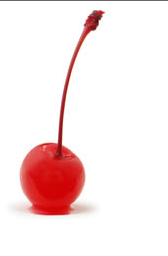Forbidden Fruit
The original maraschino cherry was made in Northern Italy from mascara cherries preserved in a liqueur made from their juices, leaves and bitter crushed pits. By the late 18th century, British bon vivants were drinking the stuff, and at the turn of the next century fashionable bar tenders in New York used the fruit and the liquor to create exotic cocktails.
Maraschinos weren’t the only new garnish at the bar. Plenty of Gilded Age drinks came with novel pickled items, even pickled French hazelnuts and pickled walnuts. Olives and cherries were the ones with lasting power.
Since the beginning, women proved especially vulnerable to the cherry. As the New York Times reported in 1910:
“A young woman engaged a room at a fashionable hotel and after ordering a Manhattan cocktail, immediately sent for another. Soon she was ordering them by the dozen. The management interfered and some one was sent to expostulate with her; also to find out how she had been able to consume so many cocktails. She was found surrounded by the full glasses with the cherry gone.”
Thanks to these sorts of stories, Temperance advocates demonized the little cherries, and blamed them for wooing women to cocktails. Later, in the 1920s when Prohibition outlawed the proper maraschino and the cocktails that went with it, an inventor in Oregon, Ernest Wiegand, came up with the sugary, red-dyed substitute we know now, made bitter with a dash of almond-extract.
This summer I’m going to make a batch of real, liqueur-soaked maraschino cherries.


Thanks!
I LOVE Manhattans.
Maybe Tom Morris will make Manhattans for us this summer?